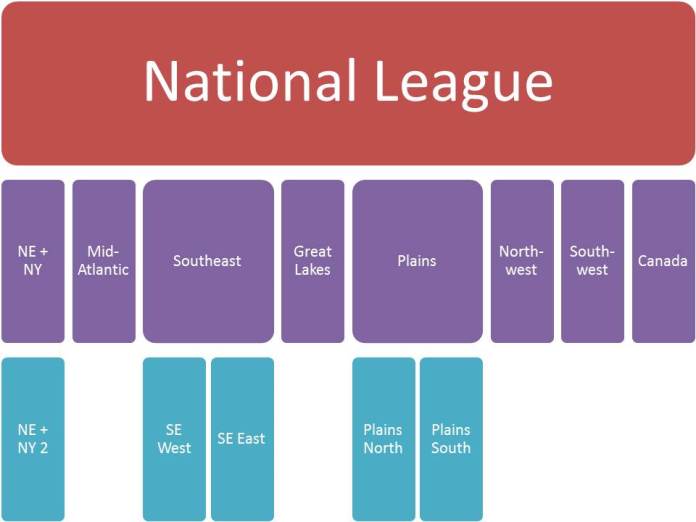We previously proposed a limited promotion & relegation system for MLS only. Truthfully, we would prefer it not be limited to that. So here we’ve decided to expand this system to support the entire landscape of soccer in the US. Below is a proposal for a United States (and access for Canada) National League with a pyramid of regionalized leagues participating in promotion and relegation. It includes issues like MLS, pyramid structure, financial regulations, etc.
League Structure
The league will be comprised of 1 National League, made up of 20 teams, and 7-10 regional leagues (1 being Canada).
National League
The national league will be made up of teams from the continental United States and Canada. Due to the burden of travel expenses on regional leagues, Alaska and Hawaii cannot be granted access.
Regions
First, let’s deal with the question of why regions at the 2nd tier in the pyramid. While many advocate for a 2 tier national system, I don’t see it making sense. All sports in the US, outside of the NFL, are followed at a more regional level. Even today, a baseball fan in Minnesota isn’t very likely to watch a World Series between the Red Sox and Diamondbacks. By regionalizing higher in the pyramid, more interest will be generated for teams in the areas they are located, as opposed to be being spread out nationally.
Each region may have multiple levels on the pyramid. Each level will be required to meet the following sizing guidelines for their top flight:
- Anywhere from 9 to 11 teams. In this case, each team will play 2 home and 2 away games against each team in the level, for a total of 32 to 40 games.
- Anywhere from 16 to 20 teams. In this case, each team will play 1 home and 1 away game against each team in the level, for a total of 30 to 38 games.
- Each season, after promotion and relegation has been sorted out, the region levels may need to re-size to accommodate the changes to these structures.
Canada will act on its own accord for how to manage their pyramid. Later, we’ll see how they gain access to the National League.
Expected regions include:
- New England + New York
- Mid- Atlantic
- Great Lakes
- Southeast (may need to be split into 2 regions)
- Plains
- West Coast (may need to be split into 2 regions)
- Canada
Each region will have rights to enter into their own broadcast deals as they see fit. This money will then be distributed to teams as the regions deem necessary.
MLS
One of the obvious counter points to promotion and relegation has been: how would that work with MLS and the money they’ve invested? MLS will be the initial starting point for the National League. As MLS is expanding to 24 teams, 4 teams will need to be relegated to the regional leagues (assuming there are no teams that want to disband at this point). This will be determined by the final 3 years of MLS. The 4 teams with the lowest accumulated points over those 3 years will be relegated to the regional leagues.
Promotion and Relegation
Considering the fact that we are advocating regionalization at such a high level in the pyramid, direct promotion and relegation is not possible. Therefore, this proposal includes a playoff system among the qualifiers from the regional leagues as well as the 4 lowest finishers from the National League.
The regions will be awarded anywhere from 0-2 automatic qualifiers in a manner similar to UEFA Champions League spots per country. Regions that have no automatic qualifiers will need to participate in a playoff for the 1 non-automatic spot. Canada will have 1 automatic qualifier awarded via a system of their choosing. This will result in a total of 16 teams in the playoffs.
Eligibility for making playoffs will include: stadium capacity and financials capability to pay travel escrow. There will likely be other qualifications necessary.
Therefore the qualifiers are as such:
- 4 teams from National League (places 17-20)
- 1 team from Canada
- 1 team from non-automatic qualifying regions
- 10 automatic qualifiers from 6-8 US regions (no region will be allowed more than 2 qualifiers to the playoffs)
Note: should there not be any non-automatic qualifying regions, there will be 11 automatic qualifying spots available.
These 16 teams will be entered into 4 groups of 4 teams. Each group will include 1 National League team and 3 randomly drawn teams. Each group will include home and away matches between each team, for a total of 6 games. The winner of each group will play the following year in the National League.
In the case where a National League team does not win their group, they will be returned to the regional league associated with their location.
An Example
| Group A | Group B | Group C | Group D | ||||
|---|---|---|---|---|---|---|---|
| NE+NY Region | 16 pts | National League place 18 | 18 pts | National League place 19 | 16 pts | Plains Region Place 2 | 12 pts |
| National League place 17 | 12 pts | Southwest Region Place 2 | 9 pts | Southeast Region Place 1 | 9 pts | Great Lakes Place 1 | 8 pts |
| Canada Region | 7 pts | Northwest Region | 7 pts | Mid-Atlantic Region | 6 pts | Southwest Region Place 1 | 8 pts |
| Plains Region Place 1 | 0 pts | Southeast Region Place 2 | 4 pts | Great Lakes Region Place 2 | 4 pts | National League place 20 | 6 pts |
In this example, the 4 teams in red have won their group and will all be playing in the National League the next season.
Financial Qualifications
While salary caps will not be included, FFP-similar statutes will be put in place to prevent over the top spending. Teams will not be able to spend more than they take in via endorsements, transfers, media, apparel, and game day sales. Outlays include salary, transfer costs, and travel escrow (and possibly others).
Infringement of this policy will result in denial of access to promotion playoffs, automatic relegation, or denial of access to Champions League play (see next section).
Champions League
Access to CONCACAF Champions League will be granted to the following teams:
- Winner of the National League
- Winner of a playoff between places 2 through 5 of the National League
- Winner of the League Cup
- Winner of the United States Open Cup
League Cup
A league cup among the 20 National League teams will be conducted each season. The top 12 teams from the previous season will earn automatic byes to the 2nd round. Places 13 through 16 will be matched up against the 4 promotion group winners from the previous season in the first round.
Timing
This new national structure would begin in 2023, the first year after the new MLS contract is to end. Starting in the 2020 season, MLS teams will begin accumulating points towards access to the National League. The 4 teams with the lowest point total over the 3 year period of 2020-2022 will be relegated to their respective regions.
This will additionally provide time for the region leagues to fill out their ranks, allow teams to construct stadiums that meet the requirements of promotion, and to sell media rights.


